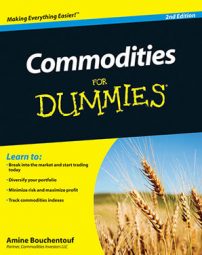Gold is unlike any other commodity because it’s one of the few commodities that can be physically stored to have its value preserved or increased over periods of time. One investment method unique to gold is to actually buy it — hard, physical gold. You can purchase gold bars, bullion, and coins and store them in a safe location as an investment.
Perhaps no other commodity offers you this unique opportunity. (Storing physical coal or uranium for investment purposes just doesn’t work, believe me!) In some countries, folks actually buy gold jewelry for the dual purpose of adornment and investment. You can get your hands on these different forms of gold:
Gold bars: Gold bars are a great investment. Whereas gold coins are more suited for smaller purchases, gold bars are ideal if you’re interested in purchasing larger quantities of gold. Despite popular depictions, gold bars come in all shapes and sizes. They can be as small as 1 gram or as large as 400 troy ounces.
Despite the size, most gold bars are high quality, with a fineness of 0.999 and above (24 karats). For a comprehensive listing of gold bars, check out The Industry Catalogue of Gold Bars Worldwide. Perhaps the only drawback of gold bars is their size, which makes them harder (and more expensive) to store.
Gold certificates: Gold certificates are a hybrid instrument that allows you to own physical gold without actually taking possession of it. As the name implies, gold certificates certify that you own a certain amount of gold, which is usually stored in a safe location by the authority that issues the gold certificates.
Owning gold certificates is a great way of owning gold because they’re safe and easy to store. When you own gold bars or coins, safety is always a concern — someone could literally steal your gold. Storage is another concern, particularly if you have large quantities of the stuff, because it can end up costing you a lot to store your gold (such as in a bank vault or personal safe).
Gold coins: One of the easiest ways to invest in physical gold is to buy gold coins. Gold coins are a great option because they give you a lot of bang for your buck. Unlike large gold bars, gold coins allow you to purchase the yellow metal in smaller quantities and units.
This flexibility offers two advantages: First, you don’t have to put up as much money to buy a gold coin, compared to buying a gold bar. Second, if you want to sell part of your gold holdings, you can easily sell five gold coins and keep five — that’s not possible when you have only one gold bar.
Another reason gold coins are nice is that you can easily and safely store them; they’re more discrete than having large gold bullion. The third reason is that they’re issued by a federal government and instantly recognized as such; in some countries (Canada and South Africa), they’re even considered legal tender. Here are the most popular types of gold coins, by country of issuance, here:
Gold eagle: The U.S. government issues the gold eagle coin; it has the full backing of Congress and the U.S. Mint. It comes in various sizes, including 1 ounce, 1/2 ounce, 1/4 ounce, and 1/10 ounce. At 22K, the gold eagle coin is a high-quality coin that you can actually use to fund an IRA account.
Gold Krugerrand: The gold Krugerrand is issued by the South African government and is one of the oldest gold coins issued in the world. It has a fineness of 0.916.
Gold maple leaf: The Canadian government backs the gold maple leaf. It’s issued by the Royal Canadian Mint and, at 24K, is the purest gold coin on the market.

